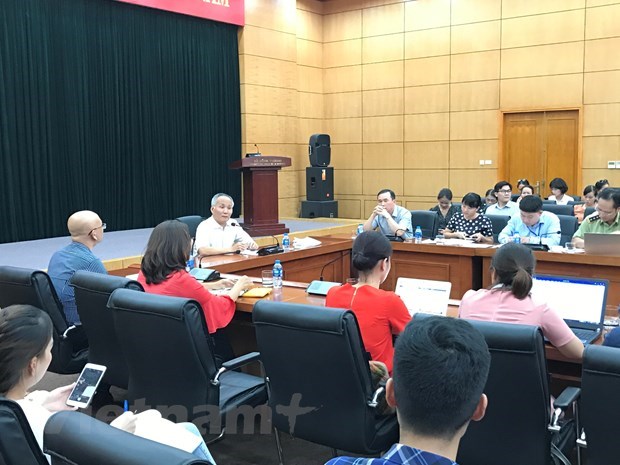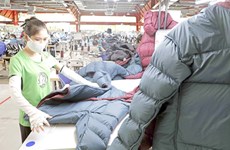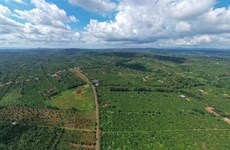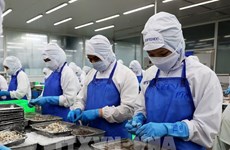New circular to help eliminate trade fraud
 Illustrative photo (Photo: VietnamPlus)
Illustrative photo (Photo: VietnamPlus)
Hanoi (VNA) –A draft circular on "Made in Vietnam" products is expected to help genuine businesses avoid accusations of fraud, said a representative of the Ministry of Industry and Trade at a press briefing in Hanoi on August 14.
The draft circular, which describes how to identify Vietnamese goods and products, will help eliminate cases that accidentally or intentionally violate provision of information on product origin.
It will also help cross out the imports of foreign commodities that are labelled as “made in Vietnam” goods, said Deputy Minister of Industry and Trade Tran Quoc Khanh.
No additional costs for businesses
Khanh said relevant agencies have issued many regulations on the origin of goods, including how a product is considered to have Vietnamese origin.
However, these regulations only apply to exported and imported goods, helping them to enjoy import tax incentives as committed in free trade agreements or serving other objectives of foreign trade management.
For manufactured goods, including those produced from imported input materials and then circulated domestically, there is no regulation stipulating which commodities are labelled "Vietnamese products" or "made in Vietnam".
Meanwhile, the absence of regulations on how a product is considered a "Vietnamese product" or "made in Vietnam" has confused many organisations and individuals when writing exactly the country of origin on product labels in accordance with the Government’s Decree. 43/2017/ ND-CP.
In contrast, some items are processed and assembled simply in Vietnam but they are also labelled "made in Vietnam", sparking public concern.
Khanh noted this circular applies to goods circulating on the Vietnamese market. Therefore, in principle, it will apply to all goods imported into Vietnam.
“If the goods imported into Vietnam have been labelled as non-Vietnamese origin, when they are circulated on the market, the publication of the country of origin shall be stipulated by Decree 43. However, this circular will be used when the imported goods are affixed with a label indicating that they are "Vietnamese products". The authorities will have the right to require the importer to prove that they are made in Vietnam before allowing the goods to go through customs procedures,” Khanh said.
The MoIT leader emphasised that the circular will not cause additional costs for enterprises because labeling of goods and publication of the country of origin on goods labels have long been compulsory requirements under Decree. 43/2017/ ND-CP.
 Deputy Minister of Industry and Trade Tran Quoc Khanh chairs a press briefing on draft "Made in Vietnam" circular.(Photo: VietnamPlus)
Deputy Minister of Industry and Trade Tran Quoc Khanh chairs a press briefing on draft "Made in Vietnam" circular.(Photo: VietnamPlus)
More tools to combat trade fraud
Regarding the definition of commodities as Vietnamese goods, Phan Van Chinh, Director of the Import and Export Department, gave two cases: goods of pure origin or produced entirely in Vietnam according to the provisions of Article 8 of this circular; and goods of impure origin or not produced entirely in Vietnam but undergoing the final processing in Vietnam which basically changes the nature of the goods as prescribed in Article 9 of this circular.
He also affirmed that organisations and individuals are only allowed to choose one of the ways specified in Clause 2, Article 4 to show that commodities are Vietnamese goods.
“According to international practice, products of pure origin often use the phrase "Products of ... " but not phrases such as" Made in ..." or "Manufactured in .., ” said Chinh.
The Import and Export Department leader added that in the ASEAN Trade in Goods Agreement (ATIGA) and other free trade agreements (FTA), the value-added content is called the "regional value content". (RVC). This name already expresses the "regional" nature of the rules of origin, meaning it allows the cumulative origin of the member states.
For example, with RVC 40 percent in ASEAN, a product with 20 percent of the value of Thailand, 10 percent of the Philippines, 5 percent of Laos and 5 percent of Vietnam will be considered meeting ASEAN origin criteria and be granted a Certificate of Origin (Form D). However, this circular stipulates stricter regulations. Specifically, the value-added ratio of 30 percent stated in the circular is the value of Vietnam only.
"With the provisions of the draft circular, many products can meet ASEAN origin criteria and receive a Certificate of Origin (Form D) but may not qualified to be considered Vietnamese goods," Chinh said.
According to Khanh, from the effective date of the circular, the presentation of Vietnam's commodity content on goods labels or documents containing information related to the goods must comply with the provisions of the circular without exception.
“The publication of the draft circular is the first step. The Ministry of Industry and Trade will then organise seminars to introduce the draft and consult relevant associations, businesses, organisations and individuals about its regulations,” he said.
At the same time, the ministry will work closely with the media to clarify the purpose of issuing the circular as well as the technical contents so that businesses and people can understand and give comments, he added./.













